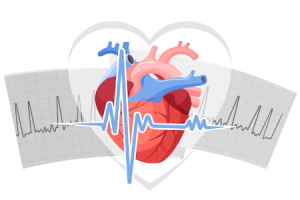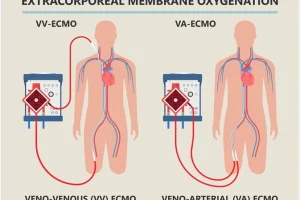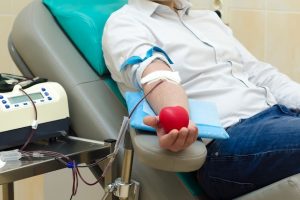Extracorporeal membrane oxygenation (ECMO) has been used increasingly for both respiratory and cardiac failure in adult patients. Indications for ECMO use in cardiac failure include severe refractory cardiogenic shock, refractory ventricular arrhythmia, active cardiopulmonary resuscitation for cardiac arrest, and acute or decompensated right heart failure. Evidence is emerging to guide the use of this therapy for some of these indications, but there remains a need for additional evidence to guide best practices. As a result, the use of ECMO may vary widely across centers. The purpose of this document is to highlight key aspects of care delivery, with the goal of codifying the current use of this rapidly growing technology. A major challenge in this field is the need to emergently deploy ECMO for cardiac failure, often with limited time to assess the appropriateness of patients for the intervention. For this reason, we advocate for a multidisciplinary team of experts to guide institutional use of this therapy and the care of patients receiving it. Rigorous patient selection and careful attention to potential complications are key factors in optimizing patient outcomes. Seamless patient transport and clearly defined pathways for transition of care to centers capable of providing heart replacement therapies (e.g., durable ventricular assist device or heart transplantation) are essential to providing the highest level of care for those patients stabilized by ECMO but unable to be weaned from the device. Ultimately, concentration of the most complex care at high-volume centers with advanced cardiac capabilities may be a way to significantly improve the care of this patient population.

Position paper for the organization of ECMO programs for cardiac failure in adults

Sigue navegando
Maternal-Fetal Results of COVID-19-Infected Pregnant Women Treated with Extracorporeal Membrane Oxygenation: A Descriptive Report
Objective: COVID-19 infection may produce severe pneumonia, mainly in the adult population. Pregnant women with severe pneumonia are at high risk…
Original ArticleVenopulmonary Artery Extracorporeal Life Support (VPa ECMO): A Novel Strategy for Refractory Hypoxemia Complicating VV ECMO
Abstract Refractory hypoxemia (RH) during venovenous extracorporeal membrane oxygenation (VV ECMO) support is a complex problem that limits the benefit…
Improving Extracorporeal Membrane Oxygenation Survival in COVID-19. Effect of a Bundle of Care
Abstract Veno-venous extracorporeal membrane oxygenation (ECMO) support surged during the COVID-19 pandemic. Our program changed the model of care pursuing…
Endocarditis infecciosa de alto riesgo embolígeno durante el embarazo: ¿manejo conservador o quirúrgico?
Presentamos el caso de una paciente de 22 años de edad con embarazo de 14 semanas y endocarditis infecciosa de…
Somatic Support with Veno-venous ECMO in a Pregnant Woman with Brain Death: A Case Report
Supporting homeostasis in a pregnant woman with brain death to achieve fetal viability is called somatic support. We present a…
Position paper for the organization of ECMO programs for cardiac failure in adults
Extracorporeal membrane oxygenation (ECMO) has been used increasingly for both respiratory and cardiac failure in adult patients. Indications for ECMO…
Tratamiento endovascular del aneurisma de aorta descendente en el adolescente con síndrome de Marfan.
En 1887 el pediatra francés Antoine Bernard Marfan describió, por primera vez el síndrome de Marfan, el cual corresponde a…
Comparación de las estrategias tradicionalesy la teoría de Stewart en la interpretación de lasalteraciones ácido-básicas en pacientes pediátricoscon disfunción multiorgánica en el postoperatoriode cirugía cardiaca
La asociación entre acidosis y el incremento dela mortalidad en los pacientes críticamente enfermos ha sido claramente establecida1-3. El reconocimiento…
Dispositivos de asistencia ventricular: una realidad en Colombia
Existen dos síndromes clínicos de falla aguda a considerar en este escenario: pacientes con choque cardiogénico agudo de novo y…
Oxigenación con membrana extracorpórea venoarterial en reanimación cardiopulmonar intrahospitalaria como puente a trasplante cardiaco
Encontramos 168 soportes mecánicos (112 neonatales-pediátricos y 56 adultos). Entre el grupo de adultos, 45 pacientes (80%) cuya indicación fue…
Eficacia del primado autólogo retrógado sobre la disminuciónen el número de transfusiones sanguíneas, en pacientes llevados acirugía cardiaca con circulación extracorpórea
Las transfusiones sanguíneas son una práctica común en cirugía cardiaca con circulación extracorpórea. Éstas son debidas a la hemodilución obligatoria…
Enfermedad de las arterias coronarias e intolerancia a la aspirina: antecedentes e información sobre el tratamiento actual
La aspirina es uno de los medicamentos más utilizados en el sistema de salud mundial y es la base para…
Experiencia con ecmo veno-venoso en pacientes con síndrome de distrés respiratorio del adulto secundario a neumonía viral. Series de casos
El uso de la oxigenación por membrana extracorpórea (ECMO) ha aumentado exponencialmente en los últimos años y ha demostrado ser…

ECMOVAD® | Todos los derechos reservados | Sitio Diseñado y Desarrollado por: ramepereira | STUDIO
Términos y Condiciones | Políticas de Privacidad












